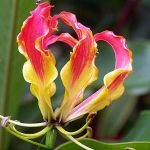| Common Name: |
Mozambique Lily |
| Other Names: |
Glory Lily, Malabar Glory Lily |
| Botanical Name: |
Gloriosa superba |
| Genus: |
Gloriosa |
| Family: |
Colchicaceae |
| Native Location: |
Africa, India |
| Cultivation: |
Rich, well-drained soil in sun. Overwatering causes discolored foliage and premature leaf fall. Plants in pots should be left dry, cool, and undisturbed in winter, and repotted in early spring. |
| Propagation: |
By seed sown in spring at 21-24°C (70-75°F); by offsets in early spring, started into growth at 16-19°C (61-66°F). |
| Harvest: |
Tubers are lifted in autumn and dried for use in pastes and powders. |
| Height: |
2.5m (8ft) |
| Width: |
30cm (12in) |
| Warning: |
All parts, especially tubers, are extremely toxic if eaten. Repeated handling of tubers causes skin irritation. |
| Variations: |
Citrina
Has yellow flowers, flushed or striped purple-red.
Rothschildiana
Has bright red flowers, yellow at the base and margins. |
| Hardiness: |
Z11 |
| Parts Used: |
Tubers |
| Properties: |
A bitter, stimulant type herb, with anti-bacterial effects. |
| Medicinal Uses: |
Internally, use of fresh tuber causes abortion; it has been used to speed labor, soaked in milk to reduce toxicity. Mainly externally for lice, scabies, and leprosy. Excess causes numbness, nausea, spasms, and unconsciousness. For use by qualified practitioners only. |
| Economic Uses: |
Used in countries of origin for making arrow poison, and to poison vermin. A source of colchicine for the pharmaceutical and horticultural industries. |
| Bibliography: |
The Encyclopedia of Herbs by Deni Bown Copyright © 1995, 2005. Dorling Kindersley Limited. pp 225-226. |
